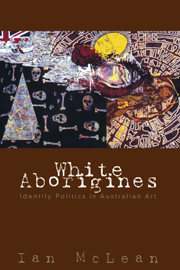Book contents
- Frontmatter
- Contents
- List of Illustrations
- Preface
- Acknowledgments
- 1 Ocean and the Antipodes
- 2 Artful Killings
- 3 The Art of Settlement
- 4 The Bad Conscience of Impressionism
- 5 Aboriginalism and Australian Nationalism
- 6 The Aboriginal Renaissance
- 7 Aboriginality and Contemporary Australian Painting
- 8 Painting for a New Republic
- Postscript: The Wandering Islands
- Notes
- Bibliography
- Index
1 - Ocean and the Antipodes
Published online by Cambridge University Press: 05 August 2012
- Frontmatter
- Contents
- List of Illustrations
- Preface
- Acknowledgments
- 1 Ocean and the Antipodes
- 2 Artful Killings
- 3 The Art of Settlement
- 4 The Bad Conscience of Impressionism
- 5 Aboriginalism and Australian Nationalism
- 6 The Aboriginal Renaissance
- 7 Aboriginality and Contemporary Australian Painting
- 8 Painting for a New Republic
- Postscript: The Wandering Islands
- Notes
- Bibliography
- Index
Summary
Like other settler colonies, Australia has a cultural ethos and national mythology which appears indifferent to its indigenous inhabitants, because their origins seem elsewhere and fantastic, even fabulous. However, non-Aboriginal Australian culture also brushes up against the fabulous. Living on the ‘other’ side of the world during a Eurocentric age, all Australians contain the trace of what ancient Aegean geographers called ‘Ocean’ (Okeanos), ‘the vast “river” thought to surround the landmass formed by Europe, Africa and Asia’.
James Romm described Ocean as ‘a vivid symbol of the gateway or barrier between inner and outer worlds’. On the inner side, Ocean is the threshold of all that is solid and everyday; on the other outer side, it melts into the primal airy chaos (apeiron) of the beyond. While stories of limitless waters west of the Pillars of Heracles (Gibraltar) provided an actual basis for the ancient Greek idea of Ocean, its function was to conceptually secure an identity, a sense of self and place. For this reason some ancient writers, such as the much travelled and world-wise Herodotus, doubted its actual existence. However, the idea remained integral to classical geography, for it provided the symbolic means of imagining identity by making place an emblem of the self. It is, for example, evident in Ptolemy's maps, which depict the known world surrounded by ocean. If, after Plato, Ptolemy imagined a large land mass on the other side of Ocean, it was an emblem of the unknown, of the non-identical.
- Type
- Chapter
- Information
- White AboriginesIdentity Politics in Australian Art, pp. 1 - 16Publisher: Cambridge University PressPrint publication year: 1998

